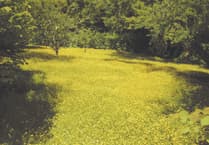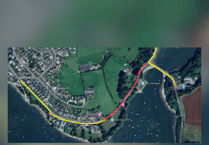Kingsbridge Natural History Society has shared three walks that show the best places to explore with a pair of binoculars this Easter.
The society’s new website includes free activities to join, locations to visit, along with links to help identify birds, flowers and butterflies.
1. West Alvington Wood. Grid reference SX 725442.
You can walk to this wood from Kingsbridge by going up Westville Hill (the road to Salcombe) and turning right down a gravel drive opposite Ashleigh Road.
Plenty of wildflowers will be out including bluebells and wood anemones. This mature wood, with lots of fallen timber will be alive with bird song and you may spot nuthatches and great spotted woodpeckers prospecting for nesting holes. Look for the messages carved on the 200 year old smooth-barked beeches, some were carved by American soldiers during the Second World War. The old chestnut trees have spirally ascending lines of bark and provide plenty of sweet nuts for the many squirrels.
2. Gara Rock to Mill Bay and back. Grid Reference SX 752373. Post code TQ8 FA.
Park at Gara Rock but don’t head for the restaurant, rather go west through a gate and along a footpath which leads you to a sunken lane leading down to the beautiful Mill Bay. Then follow the coast path as it winds back to Gara Rock.
The sunken lane is bordered by amazing 400 year old lime trees. After Mill Bay you look down from the path at the clear water of the estuary and may see sandwich terns diving for small fish. Further out gannets often put on spectacular fishing displays. Look below you to check for peregrines on rock pinnacles and ravens nest along this stretch. Migrant birds like whitethroats, blackcaps and chiffchaffs will be singing from gorse bushes. This is also a good place for early butterflies like brimstones, peacocks and holly blues. The views are wonderful and skylarks will be singing.
3. Topsham Bridge to Silveridge Weir. Grid reference SX 733511. Post code TQ7 4DR.
Park just west of the attractive stone bridge, which you cross, and turn right down the road. After 200m climb a stile on your right and follow the path beside the clear water of the River Avon. At times you will be walking on the bed of the old railway and just beyond the first intact bridge keep on the left bank (looking downstream). Just beyond the second bridge you will be at the remains of Silveridge weir. Retrace your steps when you feel you’ve gone far enough. You will see peacocks and fenced fallow deer across the river.
Look out for dippers along the river and especially at the weir. The woods hold nuthatches and buzzards often mew overhead. There’s a good chance of seeing kingfisher and grey wagtails. Butterflies should be active, with speckled woods and tortoiseshells likely and some early mayflies may lift from the water surface causing trout to rise. Newts spawn in rivulets beside the path. There will be lots of wood anemones, bluebells and wild garlic under the trees and huge skunk weed beside the river.
Kingsbridge Natural History Society has a brand new website, providing a complete resource to the local natural world, with suggested locations to visit for residents and visitors alike.
For further information, visit www.knhs.org.uk/wildlife-bodies-and-activities.





This article has no comments yet. Be the first to leave a comment.